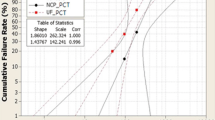Abstract
Chip on film (COF) is a new technology aggressively developed by liquid crystal display (LCD) module manufacturers. COF is a potential replacement method for tape-automated bonding (TAB) and chip-on-glass (COG) technology. COF technology has the following advantages: low power consumption, low cost, small structure, light weight and high resolution. It has become the major LCD module application. However, COF technology has several nonconforming items that should be reduced. These items include bonding misalignment, insufficient bonding strength and surface mount technology (SMT), solder joint defects, etc. The purpose of this study is to determine the optimum process parameters for COF technology improvement. An L18 orthogonal array is employed to conduct the design of experiment for finding the optimum process parameters. The results show that bonding misalignment is reduced and bonding strength increased .
Similar content being viewed by others
References
Yim MJ, Paik KW (1998) Design and understanding of anisotropic conductive film (ACFs) for LCD packaging. IEEE Trans Compon Packag Manuf Technol A 21(2):226–234
Yim MJ, Paik KW (1999) The contact resistance and reliability of anisotropically conductive film (ACF). IEEE Trans Adv Packag 22(2):166–173
Chang SM, Jou JH, Hsieh A, Chen TH, Chang CY, Wang YH, Huang CM (2001) Characteristic study of anisotropic-conductive film for chip-on-film packaging. Microelectron Reliab 41:2001–2009
Chan YC, Luk DY (2002) Effects of bonding parameters on the reliability performance of anisotropic conductive adhesive interconnects for filp-chip-on-flex packages assembly I. Different bonding temperature. Microelectron Reliab 42:1185–1194
Chan YC, Luk DY (2002) Effects of bonding parameters on the reliability performance of anisotropic conductive adhesive interconnects for filp-chip-on-flex packages assembly II. Different bonding pressure. Microelectron Reliab 42:1195–1204
Palm P, Määttänen J, Picault A, De Maquillé Y (2001) The evaluation of different base materials for high density flip chip on flex applications. Microelectron Int 18(3):27–31
Fan SH, Chan YC (2002) Effects of misalignment on electrical characteristics of ACF joints for filp chip on flex applications. Microelectron Reliab 42:1081–1090
Takatsuji H, Arai T, Tsuji S, Kuroda K, Saka H (1999) Al-based sputter-deposited film for larger liquid-crystal-display. Thin Solid Films 337:235–239
Takatsuji H, Arai T (2000) Pinholes in Al thin films: their effects on TFT characteristics and a Taguchi method analysis of their origins. Vacuum 59:606–613
Phadke MS (1989) Quality engineering using robust design. Prentice Hall, New Jersey
Ross PJ (1996) Taguchi techniques for quality engineering. McGraw-Hill, New York
Author information
Authors and Affiliations
Corresponding author
Rights and permissions
About this article
Cite this article
Li, MH., Hong, SM. Optimal parameter design for chip-on-film technology using the Taguchi method. AMT 25, 145–153 (2005). https://doi.org/10.1007/s00170-003-1824-6
Received:
Accepted:
Published:
Issue Date:
DOI: https://doi.org/10.1007/s00170-003-1824-6



